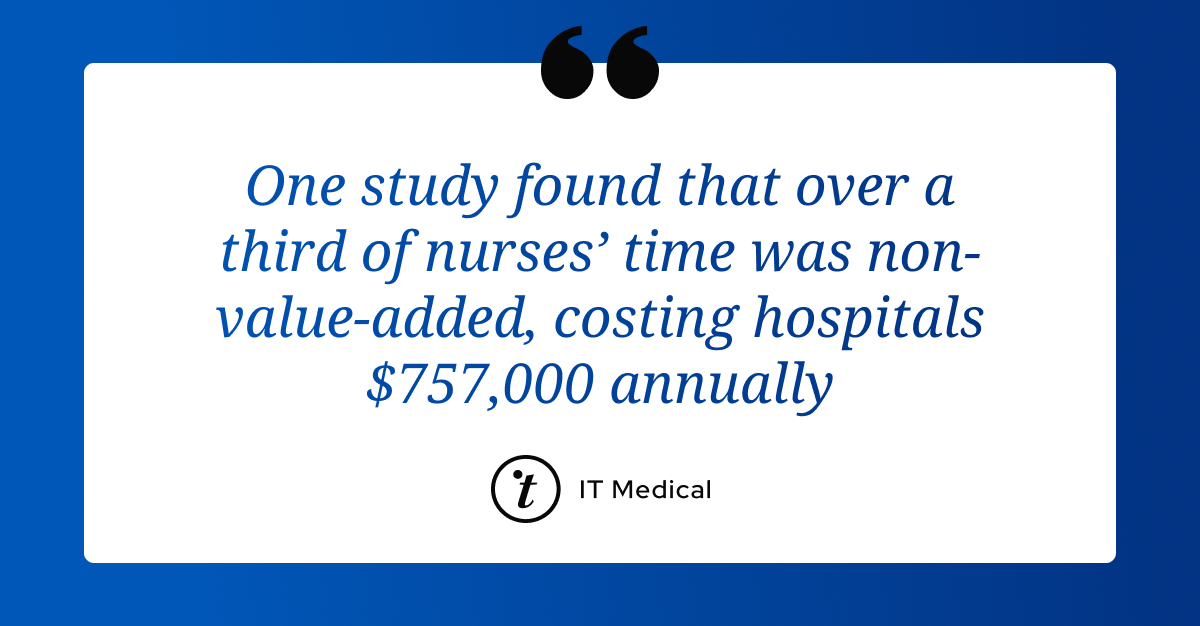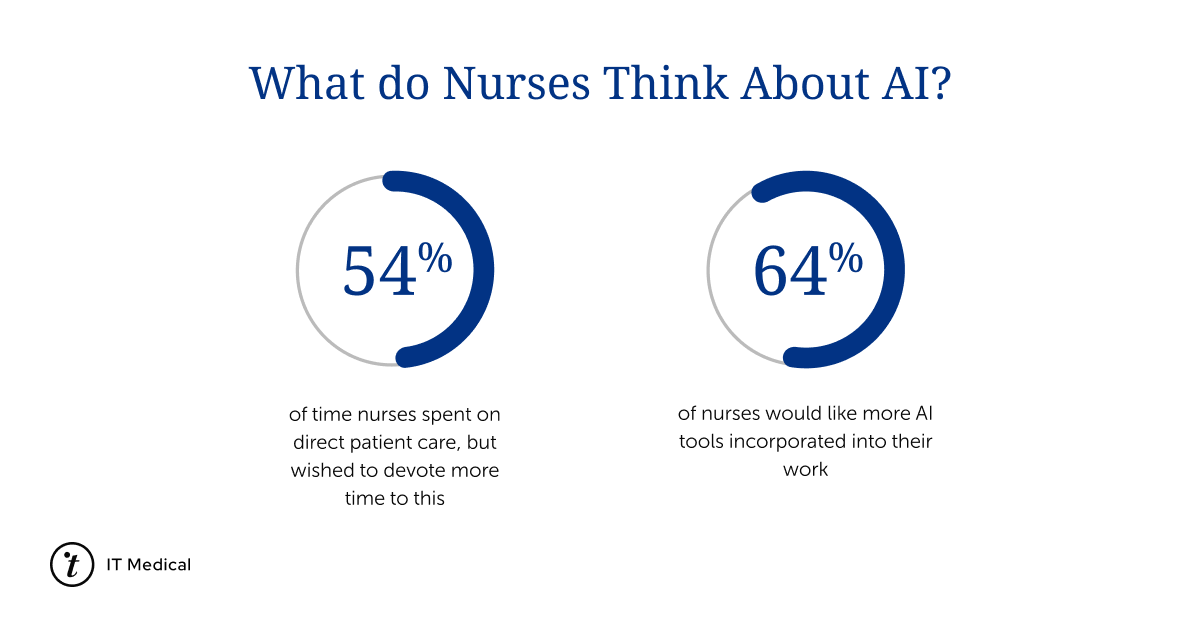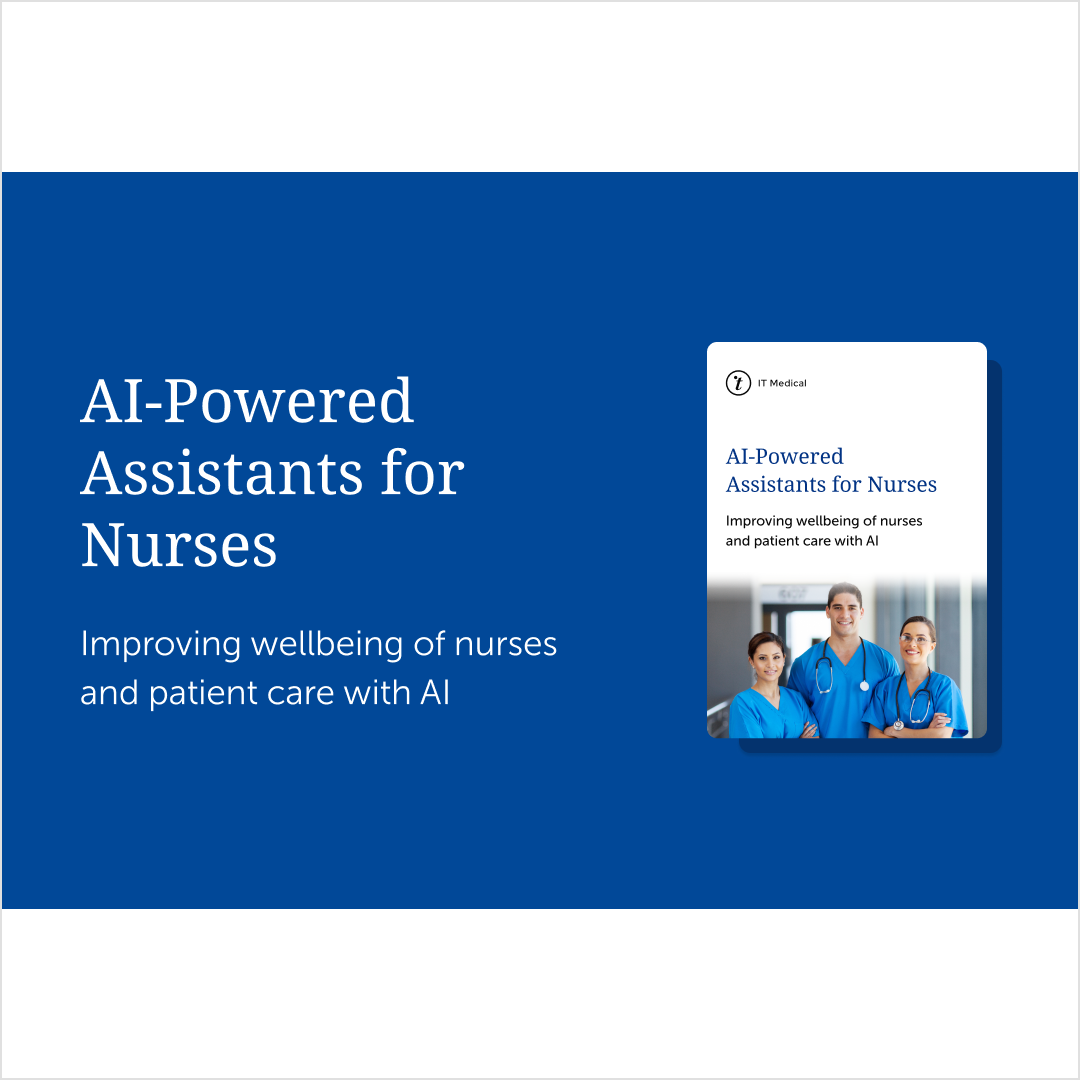The nursing workforce is under immense pressure. Hospitals are short-staffed, administrative tasks are increasing, and experienced nurses are leaving the profession faster than new ones can be trained. Burnout is becoming more common, and many nurses feel they no longer have the time or resources to focus on what matters most: caring for their patients.
At the same time, healthcare systems around the world are searching for practical ways to support their teams without compromising quality or safety. AI-powered assistants are emerging as one of the most realistic and effective tools to help address this imbalance.
While policymakers debate long-term fixes, AI-powered assistants are quietly becoming one of the most immediate and scalable solutions available today. They don’t replace nurses, they protect them. These tools reduce burnout, reclaim valuable time, and help preserve the quality of care under pressure.
This article highlights 21 evidence-based statistics from IT Medical’s whitepaper on AI in nursing and explains how digital assistants are already making a measurable difference in clinical settings. From saving time to reducing turnover, the data shows that well-designed AI tools can support nurses in the areas where they need it most.
The Nursing Crisis, by the Numbers
- The WHO projects a global shortage of 4.5 million nurses by 2030 if current patterns persist.
- Nurses spend just 54% of their time on direct patient care, and want to spend more.
- AI assistants can free up as much as 20% of nurses’ time, enabling a sharper focus on bedside care.
- Nurse turnover costs up to $88,000 per nurse, not including training and quality gaps.
- Non-value-added nursing tasks cost hospitals an estimated $757,000 annually

AI Is a Relief for the Admin Burden
- Documentation can consume up to 60% of a nurse’s shift, with some nurses documenting 875 times in just 12 hours.
- In some environments, only 21% of nursing time goes to direct care.
- A staggering 92% of healthcare professionals agree that admin overload drives burnout.
- AI could automate 30% of administrative tasks, from note transcription to scheduling.
- AI-powered tools can manage complex medication schedules, helping nurses avoid errors and reduce the mental burden of tracking multiple treatments at once. In addition to supporting clinical accuracy, this kind of automation can significantly reduce costs for healthcare systems. Medication-related inefficiencies are estimated to cost up to $528 billion annually.
Decision Support That Boosts Safety and Speed
- Predictive AI tools reduce nursing decision-making time from 35.5 to 19.8 minutes.
- 54% of nurses say they look forward to using AI in their jobs.
- AI flags subtle changes in condition before human clinicians can react, a literal life-saver.
- Tools that combine genetic, lifestyle, and wearable data improve diagnostics.
- AI assists in care personalization, offering recommendations based on holistic patient profiles.

Virtual Nursing Assistants Are Here (and Affordable)
- AI chatbots now handle medication reminders, appointment logistics, and intake questions.
- Virtual assistants can monitor patients via wearables and escalate when needed.
- Some assistants cost as little as $9/hour, offering a cost-effective way to offload routine tasks.
- These tools reduce demand on nursing staff by automating non-urgent, non-clinical interactions.
What Hospitals Stand to Gain
- Each nurse turnover event can cost $88,000, but that’s just the start. Missed patient satisfaction targets (tied to quality-based reimbursement) can cost millions more.
- 64% of nurses want more AI tools integrated into their workflow, an open invitation to act.

AI in Nurse-Led Quality Improvement
AI assistants are also becoming tools for continuous quality improvement (CQI). Nurse managers can use AI-driven insights to evaluate care processes, flag bottlenecks, and test new workflows in real time. For example, predictive analytics can highlight trends in delayed discharges or high-readmission risks, helping nurses proactively redesign care plans. When AI tools are integrated with CQI dashboards, they not only support day-to-day tasks but also become partners in strategy.
Will Nurses Trust the Tech?
One of the biggest questions around implementing AI in nursing is about trust. Will nurses want to use it? The answer depends on how the tools are introduced. When nurses are part of the design and rollout process, they’re far more likely to see the value. In fact, more than half of nurses say they’re open to using AI in their day-to-day work (1). What they don’t want is something that gets dropped into their workflow without explanation or support. The most successful tools are the ones that make their job easier without disrupting how they deliver care. If it helps them focus more on patients and less on paperwork, most nurses ready.
Implementation: 4 Practical Steps to Adopt AI Assistants
1. Identify workflow pain points
Start with where time is wasted: discharges, intake, documentation, scheduling.
2. Include nursing voices early
From pilot planning to product choice, let nurses help shape the experience.
3. Choose interoperable tools
61% of clinicians cite lack of integration as the biggest blocker to digital adoption.
4. Provide proper training
Tech is only empowering when it’s understood. Don’t just “roll it out”, roll it in, with onboarding.
Watch Out for These AI Pitfalls
- One-size-fits-all tools that don’t reflect clinical workflows
- Over-promising vendors with no nursing involvement
- AI designed around admin teams, not frontline care
- Cost-cutting rollouts that push nurses aside instead of lifting them up
Ethics and Safety Aren’t Optional
Advice for Digital Health Builders
If you’re developing AI tools for nursing workflows, focus on:
- Contextual relevance: Understand ward-level variation and complexity
- Low-friction UX: Time-pressured nurses won’t tolerate clunky systems
- Trust through transparency: Make decisions traceable and editable
- Feedback loops: Let nurses train the AI, not the other way around
To learn more about technical side of things and what healthcare CTOs should consider, you can download IT Medical’s whitepaper AI Infrastructure Checklist: 5 Best Practices for Healthcare.
Policy Relevance: AI as a Strategic Response
For national health systems, addressing the nursing shortage with more recruitment alone isn’t sustainable. AI-powered assistants offer a practical, scalable response that aligns with broader digital transformation goals. NHS England’s long-term workforce plan, for instance, emphasizes retention and smarter task allocation. AI tools that automate documentation, monitor patients remotely, and support clinical decisions are no longer “nice to have”, they’re vital infrastructure.
Preparing Nurses for AI
To ensure responsible adoption, nurse education programs must begin integrating AI literacy into their curricula. Future nurses need to understand how algorithms work, what their limitations are, and how to interpret AI-generated insights while maintaining clinical judgment. Nursing schools can partner with health tech companies to develop simulation tools and case-based learning modules. This early exposure helps graduates enter the workforce not only equipped to use AI, but to shape how it’s used.
Stronger Together
You don’t need to overhaul your entire workflow to support your nursing staff. You just need to start somewhere. Whether it’s streamlining discharge instructions or adding virtual observation assistants, every minute you give back to a nurse matters.
👉 Download the whitepaper, to learn more about AI implementation to support your nurses!

References
-
Survey: nurses cautiously optimistic about AI | Nursing Times. Accessed December 17, 2024. https://www.nursingtimes.net/digital-and-technology/survey-nurses-cautiously-optimistic-about-ai-01-08-2024/
-
Gerke S, Minssen T, Cohen G. Ethical and legal challenges of artificial intelligence-driven healthcare. Artif Intell Healthc Published online June 26, 2020:295. doi:10.1016/B978-0-12-818438-7.00012-5
-
Obermeyer Z, Powers B, Vogeli C, Mullainathan S. Dissecting racial bias in an algorithm used to manage the health of populations. Science 2019;366(6464):447-453. doi:10.1126/science.aax2342
-
Code of Ethics for Nurses. ANA. October 26, 2017. Accessed December 17, 2024. https://www.nursingworld.org/practice-policy/nursing-excellence/ethics/code-of-ethics-for-nurses/
















